HI6028 Taxation Law: Partnership Income, Expenses & FBT Analysis
VerifiedAdded on 2023/04/21
|12
|2139
|206
Homework Assignment
AI Summary
This assignment provides a detailed analysis of taxation theory, practice, and law. It addresses two main questions: determining the net income for a partnership (Brekkie and Lunch and OZ Bottle Shop) in accordance with Section 90 of ITAA 1936, including allowable deductions and depreciation calculations, and determining the employer's liability regarding taxable fringe benefits (expense payments and housing) provided to staff, in accordance with Section 20 and Section 25 of FBTAA 1986. The document includes computations, working papers, and references to relevant legal sections and rulings. Desklib offers a range of solved assignments and resources for students.
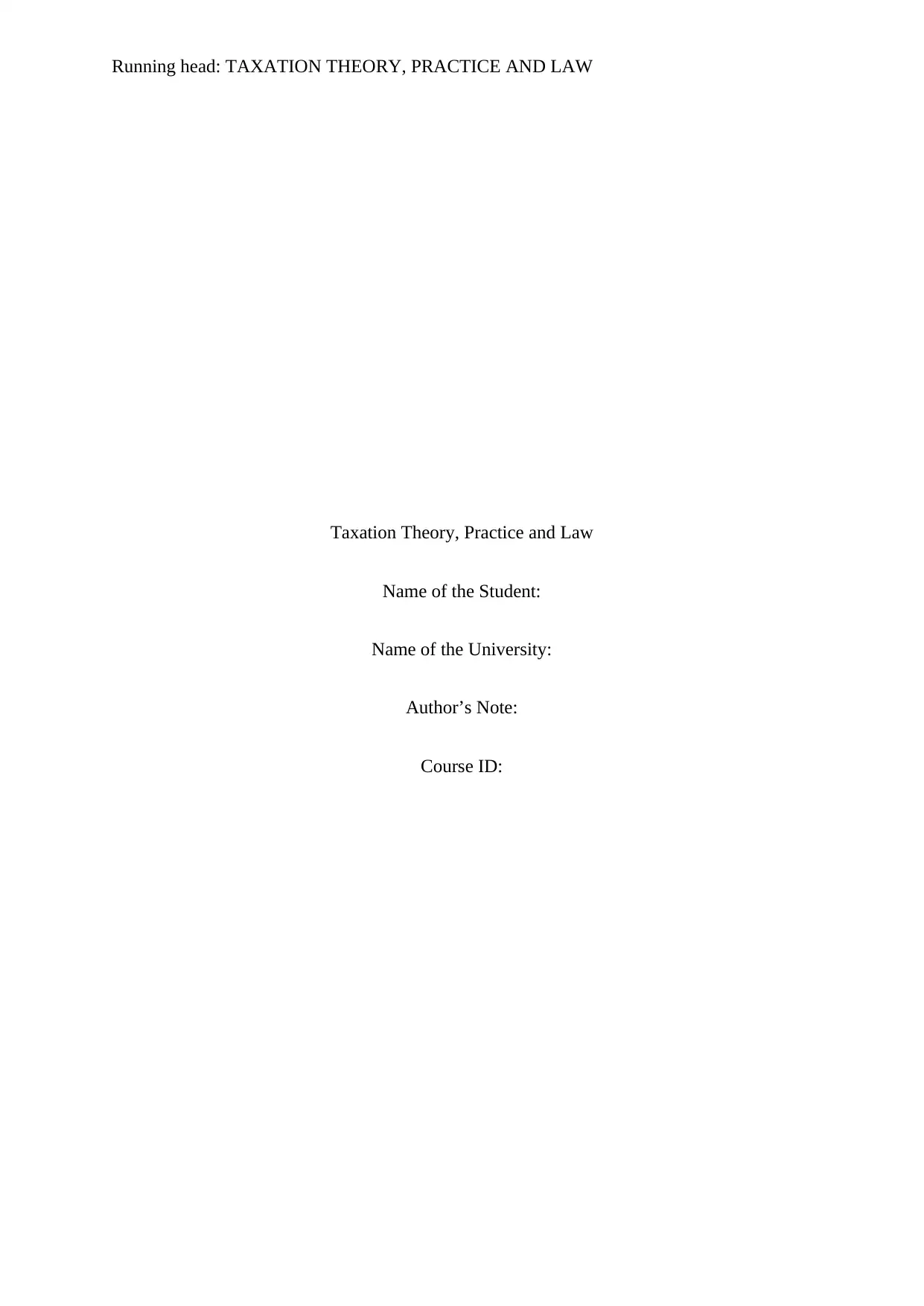
Running head: TAXATION THEORY, PRACTICE AND LAW
Taxation Theory, Practice and Law
Name of the Student:
Name of the University:
Author’s Note:
Course ID:
Taxation Theory, Practice and Law
Name of the Student:
Name of the University:
Author’s Note:
Course ID:
Paraphrase This Document
Need a fresh take? Get an instant paraphrase of this document with our AI Paraphraser
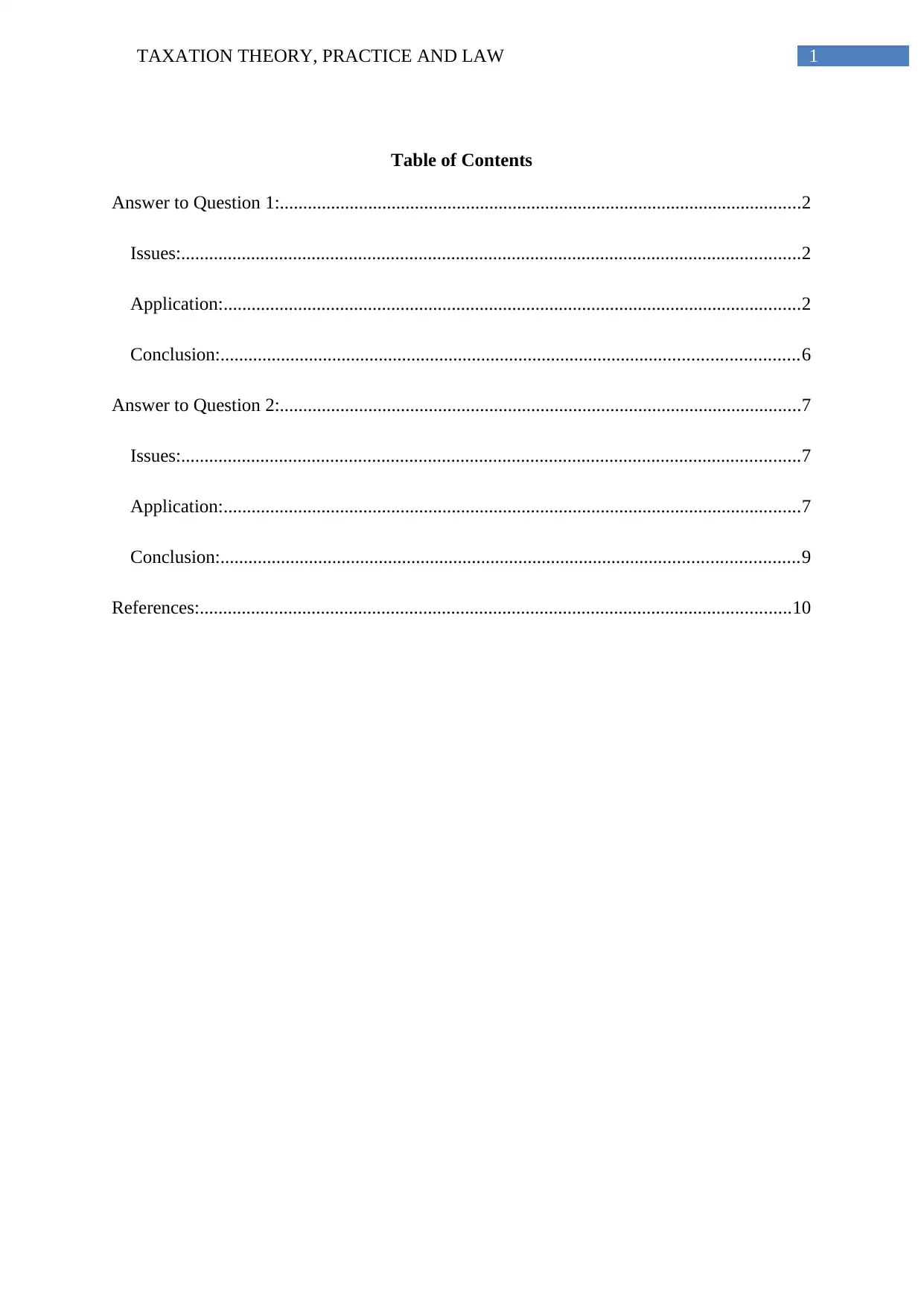
1TAXATION THEORY, PRACTICE AND LAW
Table of Contents
Answer to Question 1:................................................................................................................2
Issues:.....................................................................................................................................2
Application:............................................................................................................................2
Conclusion:............................................................................................................................6
Answer to Question 2:................................................................................................................7
Issues:.....................................................................................................................................7
Application:............................................................................................................................7
Conclusion:............................................................................................................................9
References:...............................................................................................................................10
Table of Contents
Answer to Question 1:................................................................................................................2
Issues:.....................................................................................................................................2
Application:............................................................................................................................2
Conclusion:............................................................................................................................6
Answer to Question 2:................................................................................................................7
Issues:.....................................................................................................................................7
Application:............................................................................................................................7
Conclusion:............................................................................................................................9
References:...............................................................................................................................10
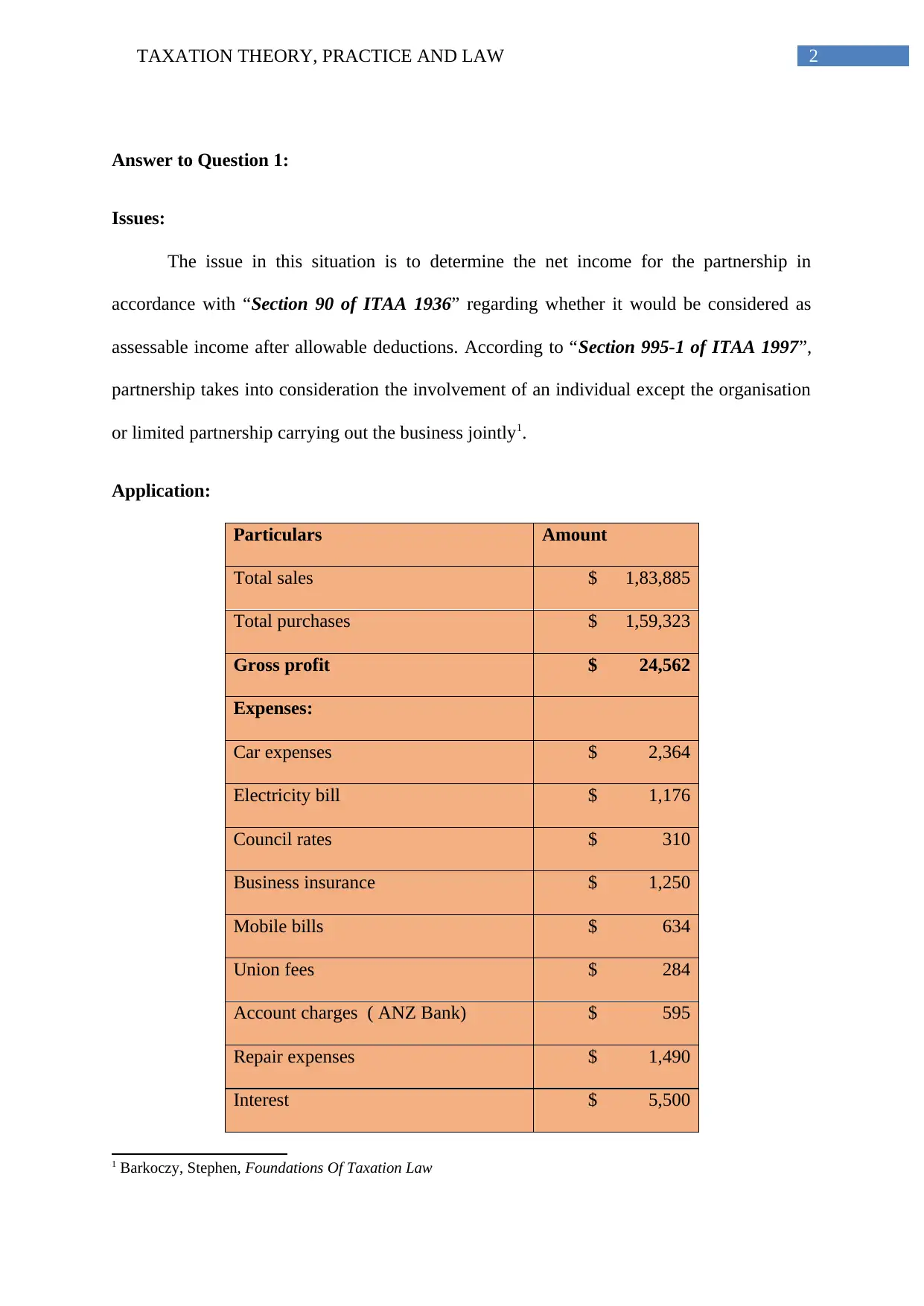
2TAXATION THEORY, PRACTICE AND LAW
Answer to Question 1:
Issues:
The issue in this situation is to determine the net income for the partnership in
accordance with “Section 90 of ITAA 1936” regarding whether it would be considered as
assessable income after allowable deductions. According to “Section 995-1 of ITAA 1997”,
partnership takes into consideration the involvement of an individual except the organisation
or limited partnership carrying out the business jointly1.
Application:
Particulars Amount
Total sales $ 1,83,885
Total purchases $ 1,59,323
Gross profit $ 24,562
Expenses:
Car expenses $ 2,364
Electricity bill $ 1,176
Council rates $ 310
Business insurance $ 1,250
Mobile bills $ 634
Union fees $ 284
Account charges ( ANZ Bank) $ 595
Repair expenses $ 1,490
Interest $ 5,500
1 Barkoczy, Stephen, Foundations Of Taxation Law
Answer to Question 1:
Issues:
The issue in this situation is to determine the net income for the partnership in
accordance with “Section 90 of ITAA 1936” regarding whether it would be considered as
assessable income after allowable deductions. According to “Section 995-1 of ITAA 1997”,
partnership takes into consideration the involvement of an individual except the organisation
or limited partnership carrying out the business jointly1.
Application:
Particulars Amount
Total sales $ 1,83,885
Total purchases $ 1,59,323
Gross profit $ 24,562
Expenses:
Car expenses $ 2,364
Electricity bill $ 1,176
Council rates $ 310
Business insurance $ 1,250
Mobile bills $ 634
Union fees $ 284
Account charges ( ANZ Bank) $ 595
Repair expenses $ 1,490
Interest $ 5,500
1 Barkoczy, Stephen, Foundations Of Taxation Law
⊘ This is a preview!⊘
Do you want full access?
Subscribe today to unlock all pages.

Trusted by 1+ million students worldwide
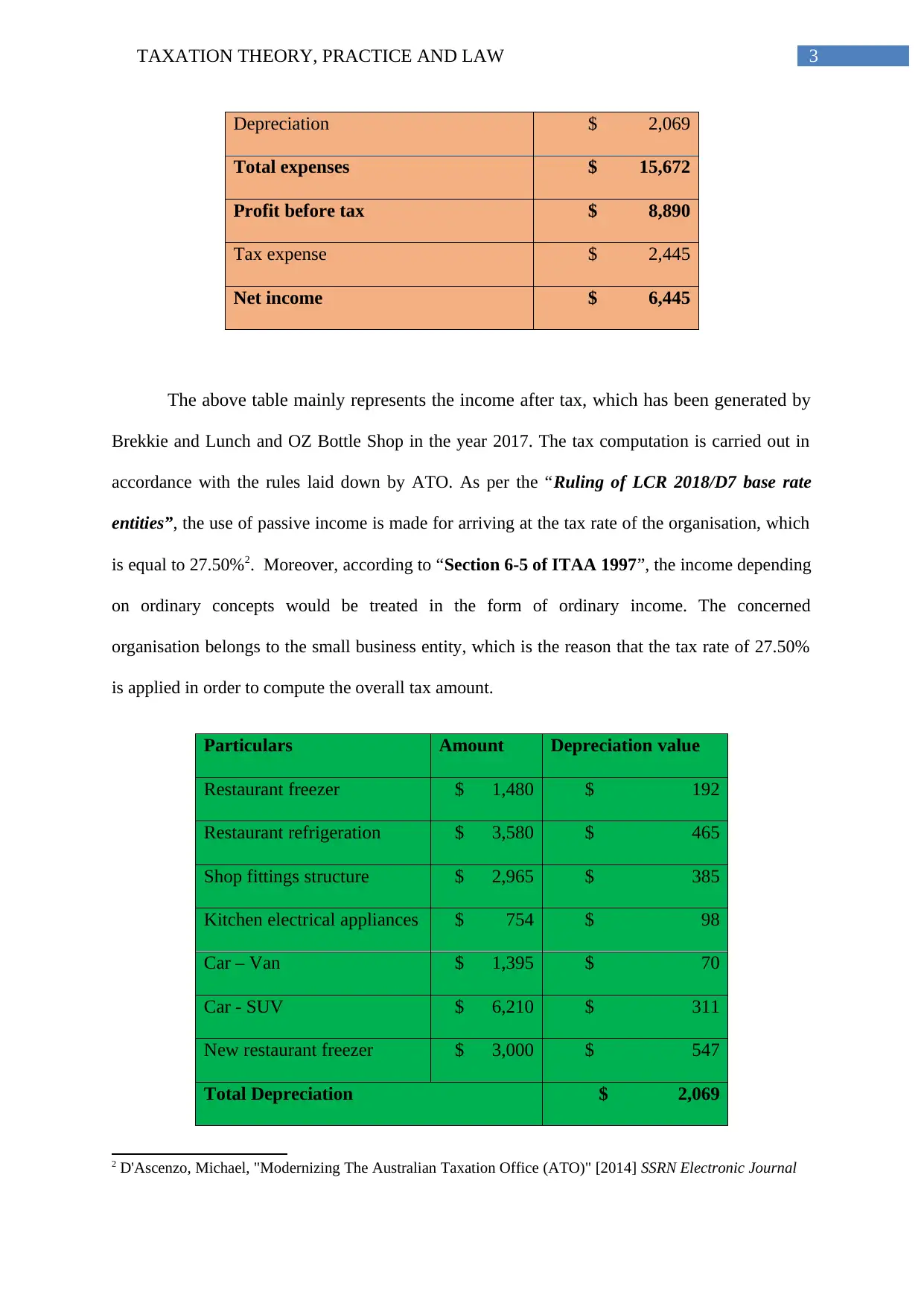
3TAXATION THEORY, PRACTICE AND LAW
Depreciation $ 2,069
Total expenses $ 15,672
Profit before tax $ 8,890
Tax expense $ 2,445
Net income $ 6,445
The above table mainly represents the income after tax, which has been generated by
Brekkie and Lunch and OZ Bottle Shop in the year 2017. The tax computation is carried out in
accordance with the rules laid down by ATO. As per the “Ruling of LCR 2018/D7 base rate
entities”, the use of passive income is made for arriving at the tax rate of the organisation, which
is equal to 27.50%2. Moreover, according to “Section 6-5 of ITAA 1997”, the income depending
on ordinary concepts would be treated in the form of ordinary income. The concerned
organisation belongs to the small business entity, which is the reason that the tax rate of 27.50%
is applied in order to compute the overall tax amount.
Particulars Amount Depreciation value
Restaurant freezer $ 1,480 $ 192
Restaurant refrigeration $ 3,580 $ 465
Shop fittings structure $ 2,965 $ 385
Kitchen electrical appliances $ 754 $ 98
Car – Van $ 1,395 $ 70
Car - SUV $ 6,210 $ 311
New restaurant freezer $ 3,000 $ 547
Total Depreciation $ 2,069
2 D'Ascenzo, Michael, "Modernizing The Australian Taxation Office (ATO)" [2014] SSRN Electronic Journal
Depreciation $ 2,069
Total expenses $ 15,672
Profit before tax $ 8,890
Tax expense $ 2,445
Net income $ 6,445
The above table mainly represents the income after tax, which has been generated by
Brekkie and Lunch and OZ Bottle Shop in the year 2017. The tax computation is carried out in
accordance with the rules laid down by ATO. As per the “Ruling of LCR 2018/D7 base rate
entities”, the use of passive income is made for arriving at the tax rate of the organisation, which
is equal to 27.50%2. Moreover, according to “Section 6-5 of ITAA 1997”, the income depending
on ordinary concepts would be treated in the form of ordinary income. The concerned
organisation belongs to the small business entity, which is the reason that the tax rate of 27.50%
is applied in order to compute the overall tax amount.
Particulars Amount Depreciation value
Restaurant freezer $ 1,480 $ 192
Restaurant refrigeration $ 3,580 $ 465
Shop fittings structure $ 2,965 $ 385
Kitchen electrical appliances $ 754 $ 98
Car – Van $ 1,395 $ 70
Car - SUV $ 6,210 $ 311
New restaurant freezer $ 3,000 $ 547
Total Depreciation $ 2,069
2 D'Ascenzo, Michael, "Modernizing The Australian Taxation Office (ATO)" [2014] SSRN Electronic Journal
Paraphrase This Document
Need a fresh take? Get an instant paraphrase of this document with our AI Paraphraser
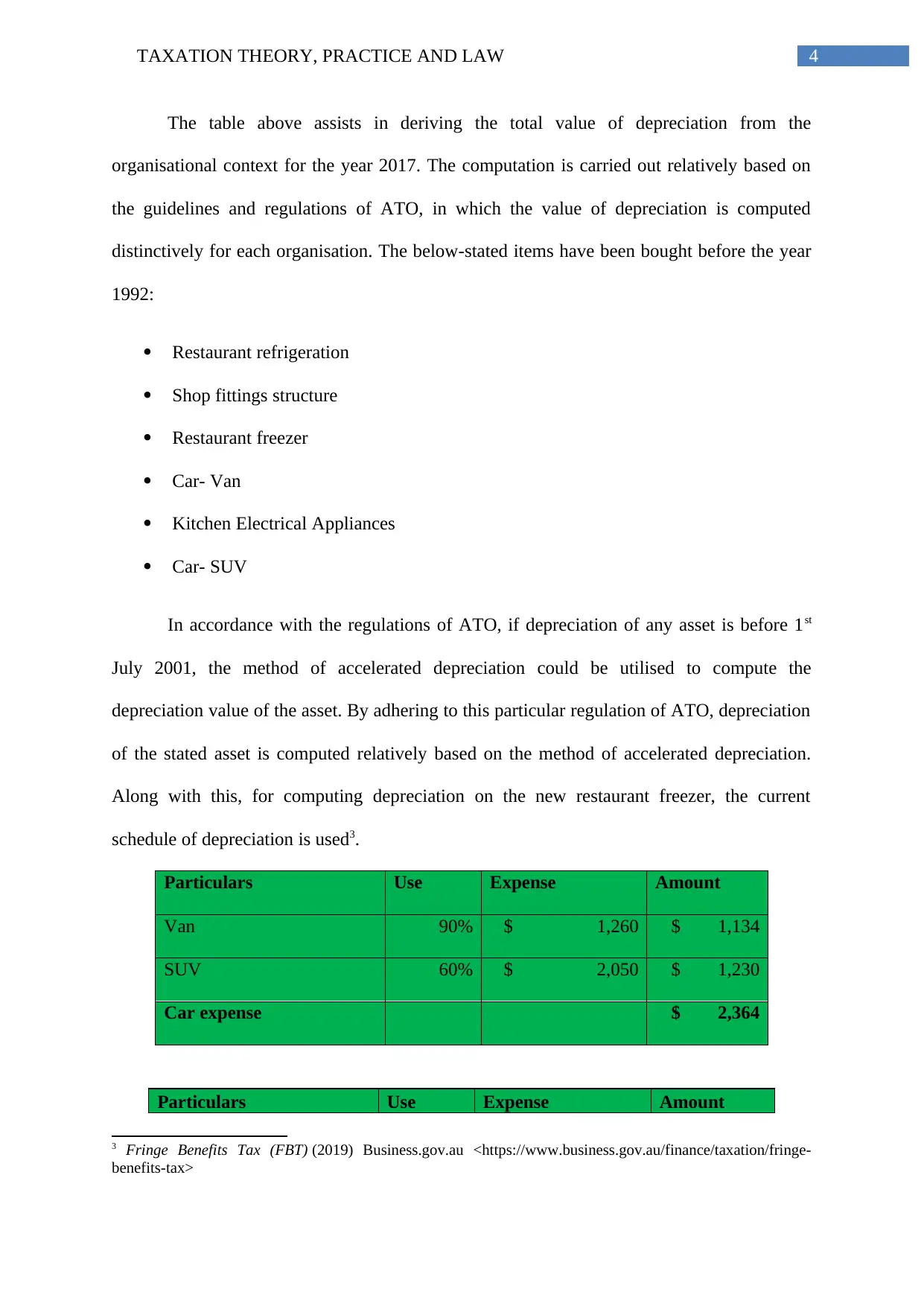
4TAXATION THEORY, PRACTICE AND LAW
The table above assists in deriving the total value of depreciation from the
organisational context for the year 2017. The computation is carried out relatively based on
the guidelines and regulations of ATO, in which the value of depreciation is computed
distinctively for each organisation. The below-stated items have been bought before the year
1992:
Restaurant refrigeration
Shop fittings structure
Restaurant freezer
Car- Van
Kitchen Electrical Appliances
Car- SUV
In accordance with the regulations of ATO, if depreciation of any asset is before 1st
July 2001, the method of accelerated depreciation could be utilised to compute the
depreciation value of the asset. By adhering to this particular regulation of ATO, depreciation
of the stated asset is computed relatively based on the method of accelerated depreciation.
Along with this, for computing depreciation on the new restaurant freezer, the current
schedule of depreciation is used3.
Particulars Use Expense Amount
Van 90% $ 1,260 $ 1,134
SUV 60% $ 2,050 $ 1,230
Car expense $ 2,364
Particulars Use Expense Amount
3 Fringe Benefits Tax (FBT) (2019) Business.gov.au <https://www.business.gov.au/finance/taxation/fringe-
benefits-tax>
The table above assists in deriving the total value of depreciation from the
organisational context for the year 2017. The computation is carried out relatively based on
the guidelines and regulations of ATO, in which the value of depreciation is computed
distinctively for each organisation. The below-stated items have been bought before the year
1992:
Restaurant refrigeration
Shop fittings structure
Restaurant freezer
Car- Van
Kitchen Electrical Appliances
Car- SUV
In accordance with the regulations of ATO, if depreciation of any asset is before 1st
July 2001, the method of accelerated depreciation could be utilised to compute the
depreciation value of the asset. By adhering to this particular regulation of ATO, depreciation
of the stated asset is computed relatively based on the method of accelerated depreciation.
Along with this, for computing depreciation on the new restaurant freezer, the current
schedule of depreciation is used3.
Particulars Use Expense Amount
Van 90% $ 1,260 $ 1,134
SUV 60% $ 2,050 $ 1,230
Car expense $ 2,364
Particulars Use Expense Amount
3 Fringe Benefits Tax (FBT) (2019) Business.gov.au <https://www.business.gov.au/finance/taxation/fringe-
benefits-tax>
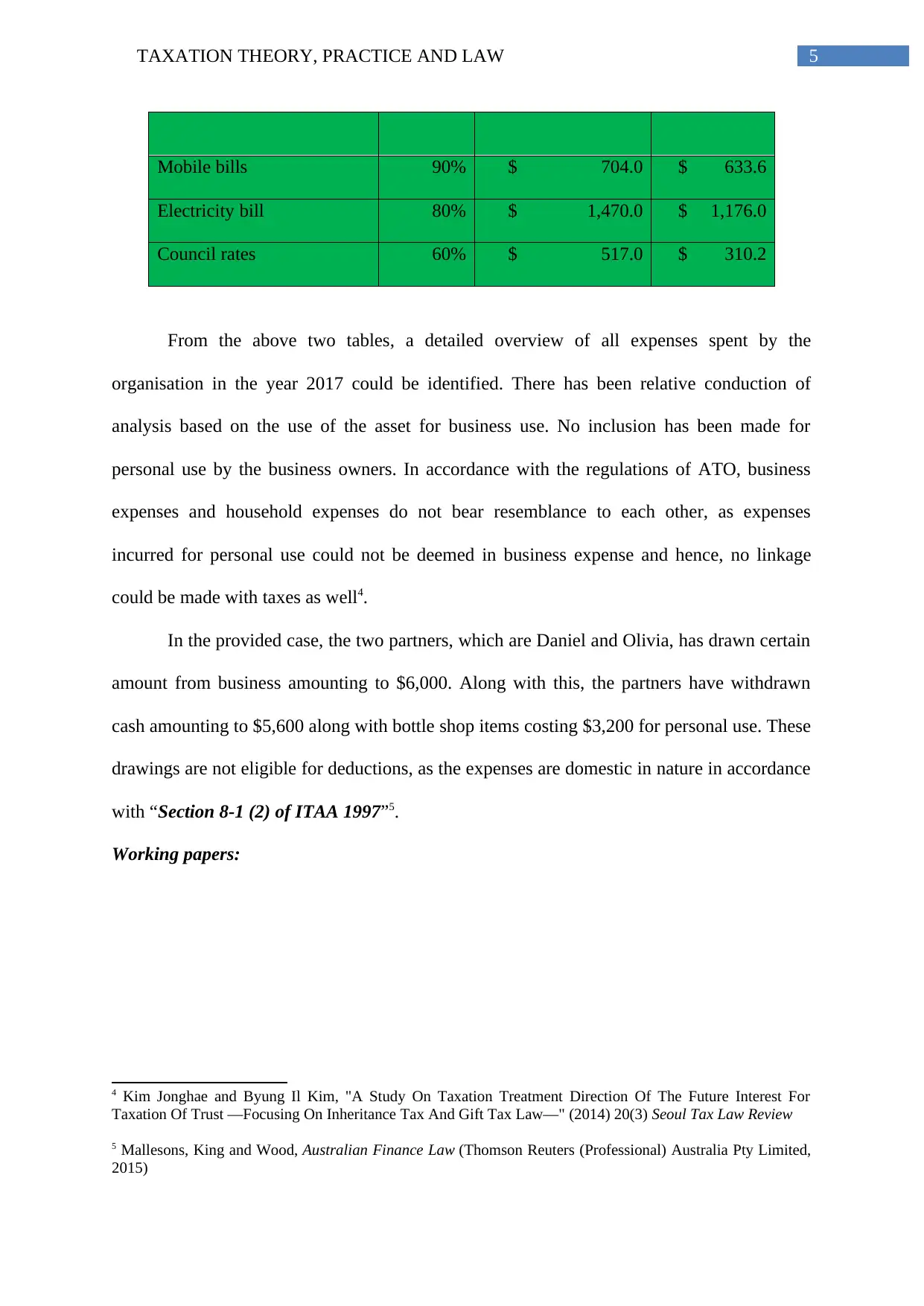
5TAXATION THEORY, PRACTICE AND LAW
Mobile bills 90% $ 704.0 $ 633.6
Electricity bill 80% $ 1,470.0 $ 1,176.0
Council rates 60% $ 517.0 $ 310.2
From the above two tables, a detailed overview of all expenses spent by the
organisation in the year 2017 could be identified. There has been relative conduction of
analysis based on the use of the asset for business use. No inclusion has been made for
personal use by the business owners. In accordance with the regulations of ATO, business
expenses and household expenses do not bear resemblance to each other, as expenses
incurred for personal use could not be deemed in business expense and hence, no linkage
could be made with taxes as well4.
In the provided case, the two partners, which are Daniel and Olivia, has drawn certain
amount from business amounting to $6,000. Along with this, the partners have withdrawn
cash amounting to $5,600 along with bottle shop items costing $3,200 for personal use. These
drawings are not eligible for deductions, as the expenses are domestic in nature in accordance
with “Section 8-1 (2) of ITAA 1997”5.
Working papers:
4 Kim Jonghae and Byung Il Kim, "A Study On Taxation Treatment Direction Of The Future Interest For
Taxation Of Trust ―Focusing On Inheritance Tax And Gift Tax Law―" (2014) 20(3) Seoul Tax Law Review
5 Mallesons, King and Wood, Australian Finance Law (Thomson Reuters (Professional) Australia Pty Limited,
2015)
Mobile bills 90% $ 704.0 $ 633.6
Electricity bill 80% $ 1,470.0 $ 1,176.0
Council rates 60% $ 517.0 $ 310.2
From the above two tables, a detailed overview of all expenses spent by the
organisation in the year 2017 could be identified. There has been relative conduction of
analysis based on the use of the asset for business use. No inclusion has been made for
personal use by the business owners. In accordance with the regulations of ATO, business
expenses and household expenses do not bear resemblance to each other, as expenses
incurred for personal use could not be deemed in business expense and hence, no linkage
could be made with taxes as well4.
In the provided case, the two partners, which are Daniel and Olivia, has drawn certain
amount from business amounting to $6,000. Along with this, the partners have withdrawn
cash amounting to $5,600 along with bottle shop items costing $3,200 for personal use. These
drawings are not eligible for deductions, as the expenses are domestic in nature in accordance
with “Section 8-1 (2) of ITAA 1997”5.
Working papers:
4 Kim Jonghae and Byung Il Kim, "A Study On Taxation Treatment Direction Of The Future Interest For
Taxation Of Trust ―Focusing On Inheritance Tax And Gift Tax Law―" (2014) 20(3) Seoul Tax Law Review
5 Mallesons, King and Wood, Australian Finance Law (Thomson Reuters (Professional) Australia Pty Limited,
2015)
⊘ This is a preview!⊘
Do you want full access?
Subscribe today to unlock all pages.

Trusted by 1+ million students worldwide
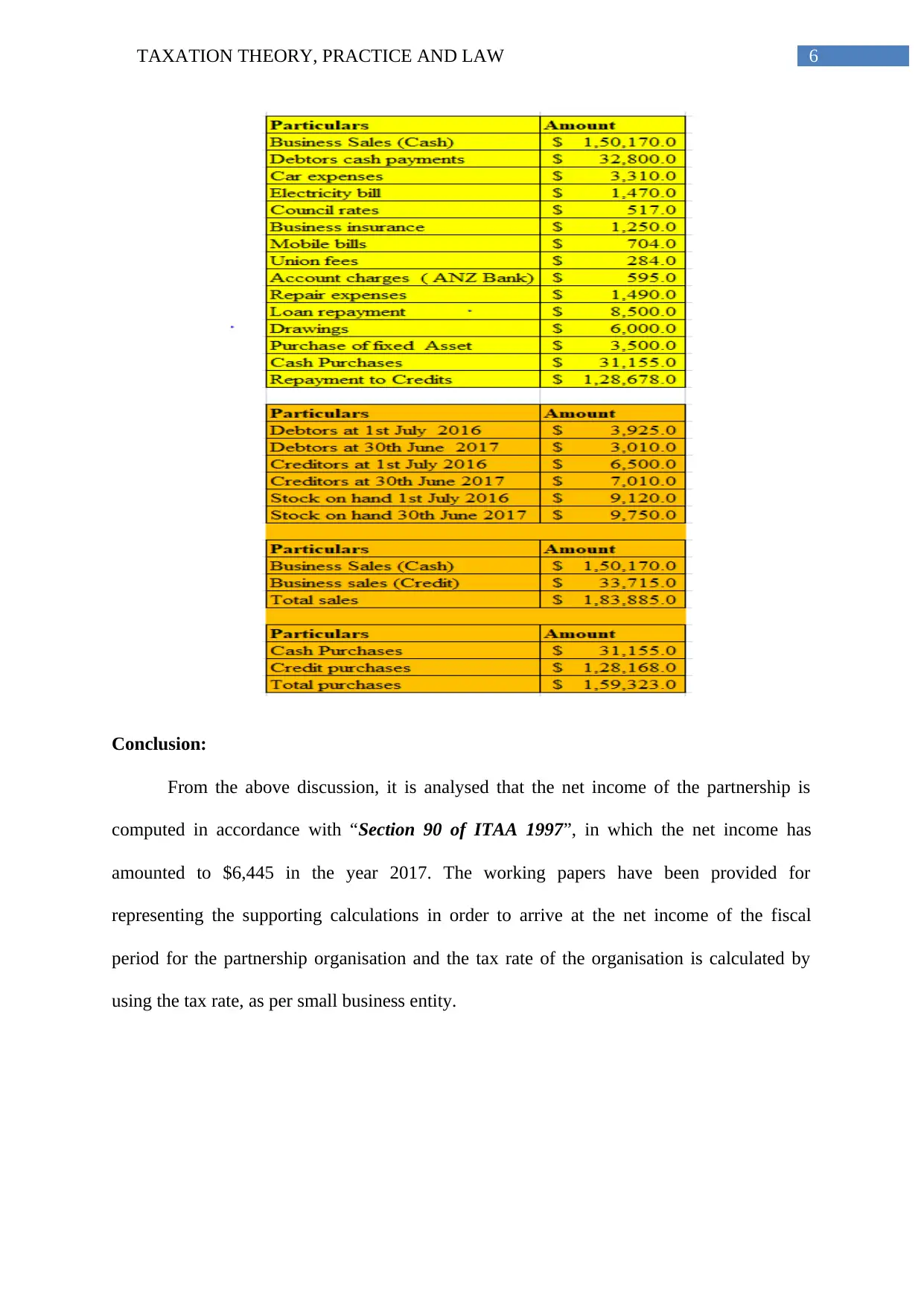
6TAXATION THEORY, PRACTICE AND LAW
Conclusion:
From the above discussion, it is analysed that the net income of the partnership is
computed in accordance with “Section 90 of ITAA 1997”, in which the net income has
amounted to $6,445 in the year 2017. The working papers have been provided for
representing the supporting calculations in order to arrive at the net income of the fiscal
period for the partnership organisation and the tax rate of the organisation is calculated by
using the tax rate, as per small business entity.
Conclusion:
From the above discussion, it is analysed that the net income of the partnership is
computed in accordance with “Section 90 of ITAA 1997”, in which the net income has
amounted to $6,445 in the year 2017. The working papers have been provided for
representing the supporting calculations in order to arrive at the net income of the fiscal
period for the partnership organisation and the tax rate of the organisation is calculated by
using the tax rate, as per small business entity.
Paraphrase This Document
Need a fresh take? Get an instant paraphrase of this document with our AI Paraphraser
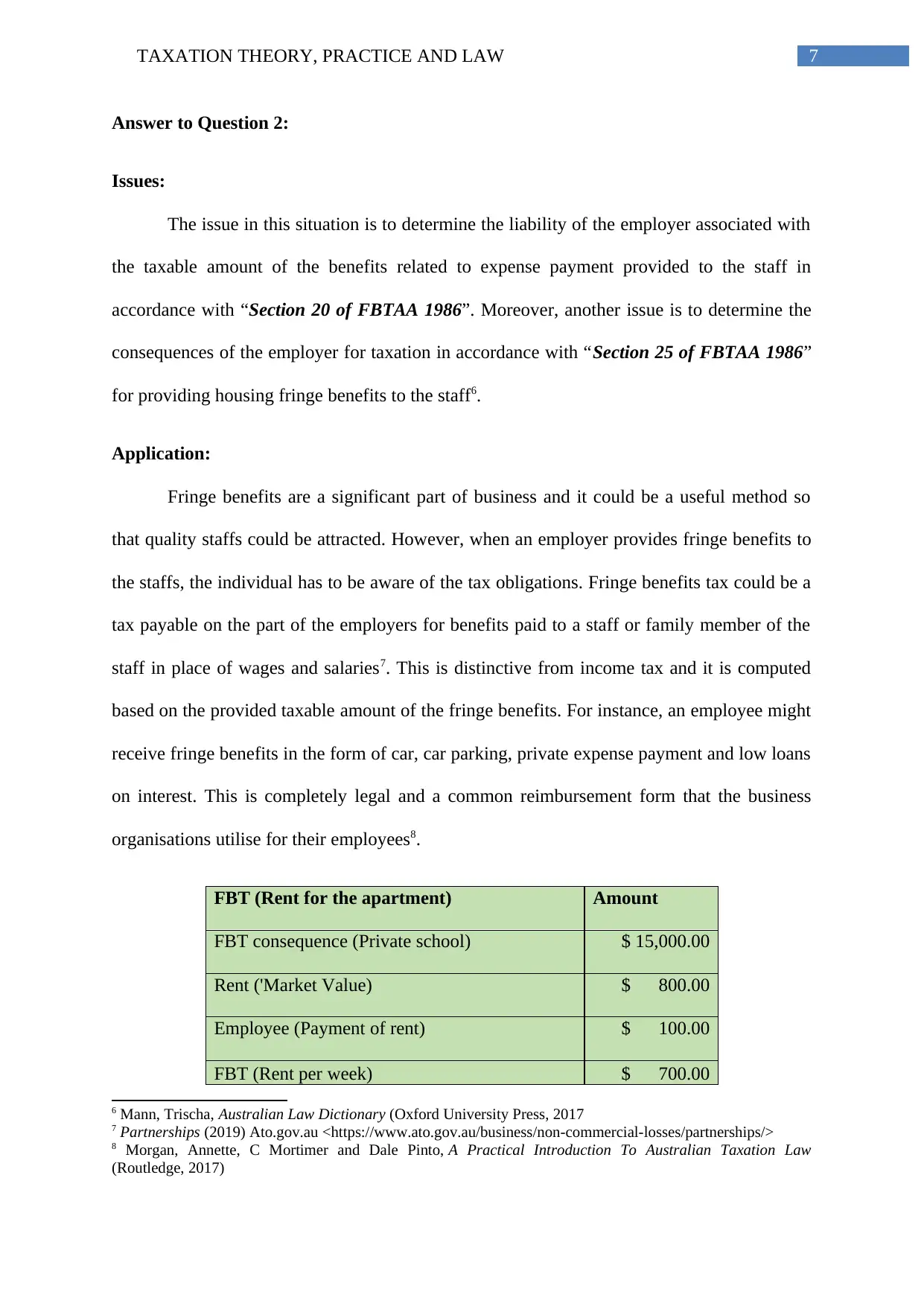
7TAXATION THEORY, PRACTICE AND LAW
Answer to Question 2:
Issues:
The issue in this situation is to determine the liability of the employer associated with
the taxable amount of the benefits related to expense payment provided to the staff in
accordance with “Section 20 of FBTAA 1986”. Moreover, another issue is to determine the
consequences of the employer for taxation in accordance with “Section 25 of FBTAA 1986”
for providing housing fringe benefits to the staff6.
Application:
Fringe benefits are a significant part of business and it could be a useful method so
that quality staffs could be attracted. However, when an employer provides fringe benefits to
the staffs, the individual has to be aware of the tax obligations. Fringe benefits tax could be a
tax payable on the part of the employers for benefits paid to a staff or family member of the
staff in place of wages and salaries7. This is distinctive from income tax and it is computed
based on the provided taxable amount of the fringe benefits. For instance, an employee might
receive fringe benefits in the form of car, car parking, private expense payment and low loans
on interest. This is completely legal and a common reimbursement form that the business
organisations utilise for their employees8.
FBT (Rent for the apartment) Amount
FBT consequence (Private school) $ 15,000.00
Rent ('Market Value) $ 800.00
Employee (Payment of rent) $ 100.00
FBT (Rent per week) $ 700.00
6 Mann, Trischa, Australian Law Dictionary (Oxford University Press, 2017
7 Partnerships (2019) Ato.gov.au <https://www.ato.gov.au/business/non-commercial-losses/partnerships/>
8 Morgan, Annette, C Mortimer and Dale Pinto, A Practical Introduction To Australian Taxation Law
(Routledge, 2017)
Answer to Question 2:
Issues:
The issue in this situation is to determine the liability of the employer associated with
the taxable amount of the benefits related to expense payment provided to the staff in
accordance with “Section 20 of FBTAA 1986”. Moreover, another issue is to determine the
consequences of the employer for taxation in accordance with “Section 25 of FBTAA 1986”
for providing housing fringe benefits to the staff6.
Application:
Fringe benefits are a significant part of business and it could be a useful method so
that quality staffs could be attracted. However, when an employer provides fringe benefits to
the staffs, the individual has to be aware of the tax obligations. Fringe benefits tax could be a
tax payable on the part of the employers for benefits paid to a staff or family member of the
staff in place of wages and salaries7. This is distinctive from income tax and it is computed
based on the provided taxable amount of the fringe benefits. For instance, an employee might
receive fringe benefits in the form of car, car parking, private expense payment and low loans
on interest. This is completely legal and a common reimbursement form that the business
organisations utilise for their employees8.
FBT (Rent for the apartment) Amount
FBT consequence (Private school) $ 15,000.00
Rent ('Market Value) $ 800.00
Employee (Payment of rent) $ 100.00
FBT (Rent per week) $ 700.00
6 Mann, Trischa, Australian Law Dictionary (Oxford University Press, 2017
7 Partnerships (2019) Ato.gov.au <https://www.ato.gov.au/business/non-commercial-losses/partnerships/>
8 Morgan, Annette, C Mortimer and Dale Pinto, A Practical Introduction To Australian Taxation Law
(Routledge, 2017)
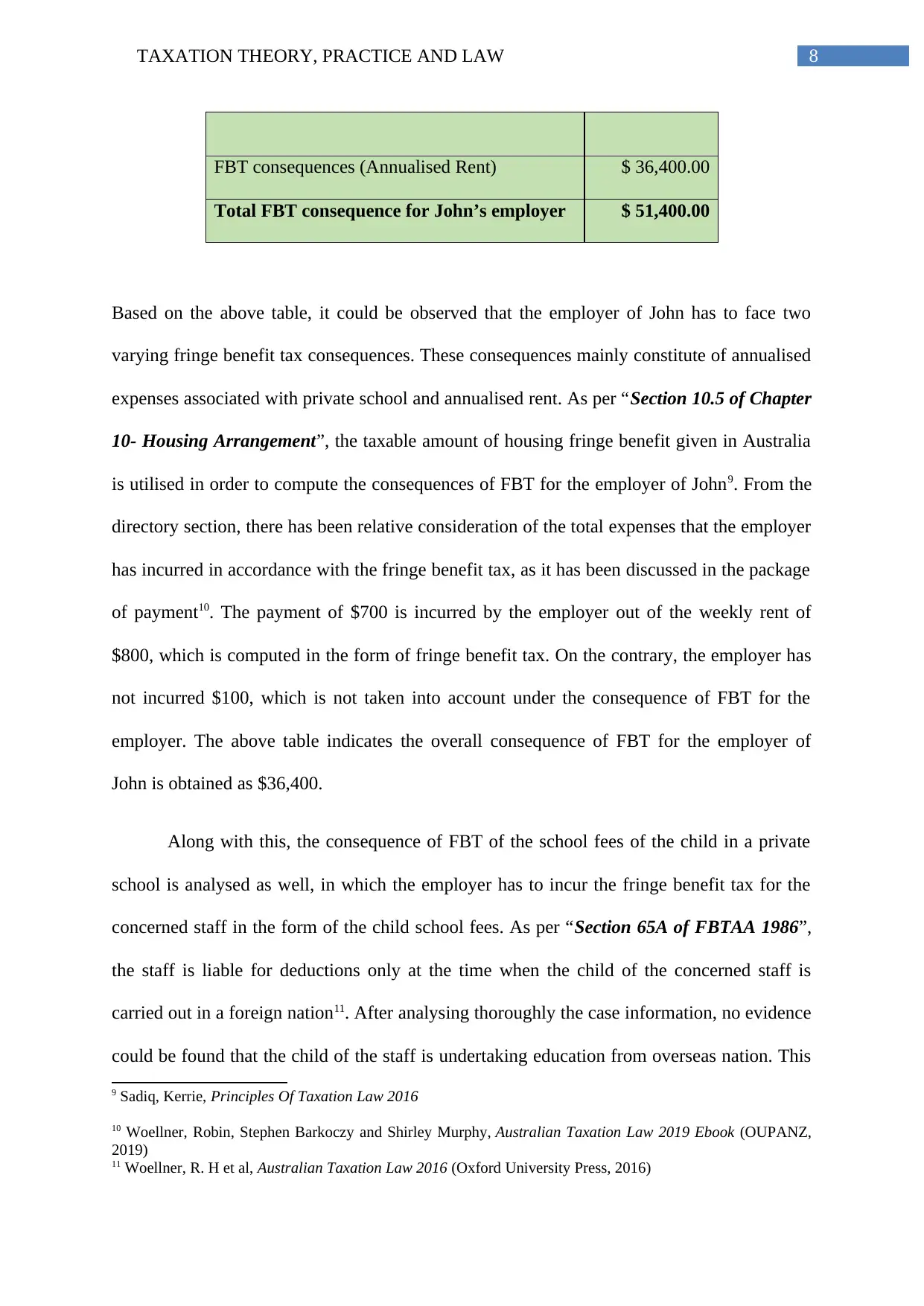
8TAXATION THEORY, PRACTICE AND LAW
FBT consequences (Annualised Rent) $ 36,400.00
Total FBT consequence for John’s employer $ 51,400.00
Based on the above table, it could be observed that the employer of John has to face two
varying fringe benefit tax consequences. These consequences mainly constitute of annualised
expenses associated with private school and annualised rent. As per “Section 10.5 of Chapter
10- Housing Arrangement”, the taxable amount of housing fringe benefit given in Australia
is utilised in order to compute the consequences of FBT for the employer of John9. From the
directory section, there has been relative consideration of the total expenses that the employer
has incurred in accordance with the fringe benefit tax, as it has been discussed in the package
of payment10. The payment of $700 is incurred by the employer out of the weekly rent of
$800, which is computed in the form of fringe benefit tax. On the contrary, the employer has
not incurred $100, which is not taken into account under the consequence of FBT for the
employer. The above table indicates the overall consequence of FBT for the employer of
John is obtained as $36,400.
Along with this, the consequence of FBT of the school fees of the child in a private
school is analysed as well, in which the employer has to incur the fringe benefit tax for the
concerned staff in the form of the child school fees. As per “Section 65A of FBTAA 1986”,
the staff is liable for deductions only at the time when the child of the concerned staff is
carried out in a foreign nation11. After analysing thoroughly the case information, no evidence
could be found that the child of the staff is undertaking education from overseas nation. This
9 Sadiq, Kerrie, Principles Of Taxation Law 2016
10 Woellner, Robin, Stephen Barkoczy and Shirley Murphy, Australian Taxation Law 2019 Ebook (OUPANZ,
2019)
11 Woellner, R. H et al, Australian Taxation Law 2016 (Oxford University Press, 2016)
FBT consequences (Annualised Rent) $ 36,400.00
Total FBT consequence for John’s employer $ 51,400.00
Based on the above table, it could be observed that the employer of John has to face two
varying fringe benefit tax consequences. These consequences mainly constitute of annualised
expenses associated with private school and annualised rent. As per “Section 10.5 of Chapter
10- Housing Arrangement”, the taxable amount of housing fringe benefit given in Australia
is utilised in order to compute the consequences of FBT for the employer of John9. From the
directory section, there has been relative consideration of the total expenses that the employer
has incurred in accordance with the fringe benefit tax, as it has been discussed in the package
of payment10. The payment of $700 is incurred by the employer out of the weekly rent of
$800, which is computed in the form of fringe benefit tax. On the contrary, the employer has
not incurred $100, which is not taken into account under the consequence of FBT for the
employer. The above table indicates the overall consequence of FBT for the employer of
John is obtained as $36,400.
Along with this, the consequence of FBT of the school fees of the child in a private
school is analysed as well, in which the employer has to incur the fringe benefit tax for the
concerned staff in the form of the child school fees. As per “Section 65A of FBTAA 1986”,
the staff is liable for deductions only at the time when the child of the concerned staff is
carried out in a foreign nation11. After analysing thoroughly the case information, no evidence
could be found that the child of the staff is undertaking education from overseas nation. This
9 Sadiq, Kerrie, Principles Of Taxation Law 2016
10 Woellner, Robin, Stephen Barkoczy and Shirley Murphy, Australian Taxation Law 2019 Ebook (OUPANZ,
2019)
11 Woellner, R. H et al, Australian Taxation Law 2016 (Oxford University Press, 2016)
⊘ This is a preview!⊘
Do you want full access?
Subscribe today to unlock all pages.

Trusted by 1+ million students worldwide
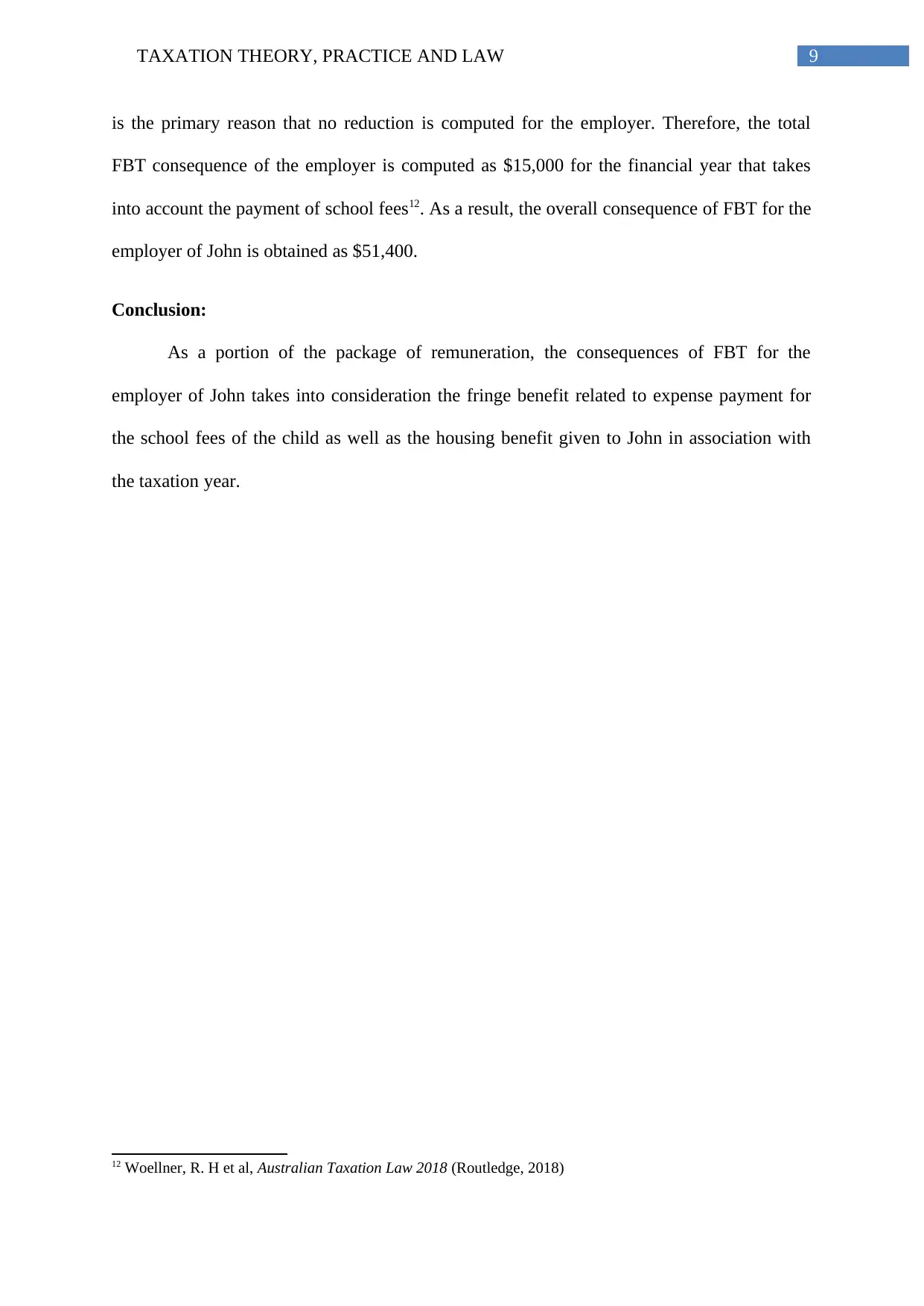
9TAXATION THEORY, PRACTICE AND LAW
is the primary reason that no reduction is computed for the employer. Therefore, the total
FBT consequence of the employer is computed as $15,000 for the financial year that takes
into account the payment of school fees12. As a result, the overall consequence of FBT for the
employer of John is obtained as $51,400.
Conclusion:
As a portion of the package of remuneration, the consequences of FBT for the
employer of John takes into consideration the fringe benefit related to expense payment for
the school fees of the child as well as the housing benefit given to John in association with
the taxation year.
12 Woellner, R. H et al, Australian Taxation Law 2018 (Routledge, 2018)
is the primary reason that no reduction is computed for the employer. Therefore, the total
FBT consequence of the employer is computed as $15,000 for the financial year that takes
into account the payment of school fees12. As a result, the overall consequence of FBT for the
employer of John is obtained as $51,400.
Conclusion:
As a portion of the package of remuneration, the consequences of FBT for the
employer of John takes into consideration the fringe benefit related to expense payment for
the school fees of the child as well as the housing benefit given to John in association with
the taxation year.
12 Woellner, R. H et al, Australian Taxation Law 2018 (Routledge, 2018)
Paraphrase This Document
Need a fresh take? Get an instant paraphrase of this document with our AI Paraphraser
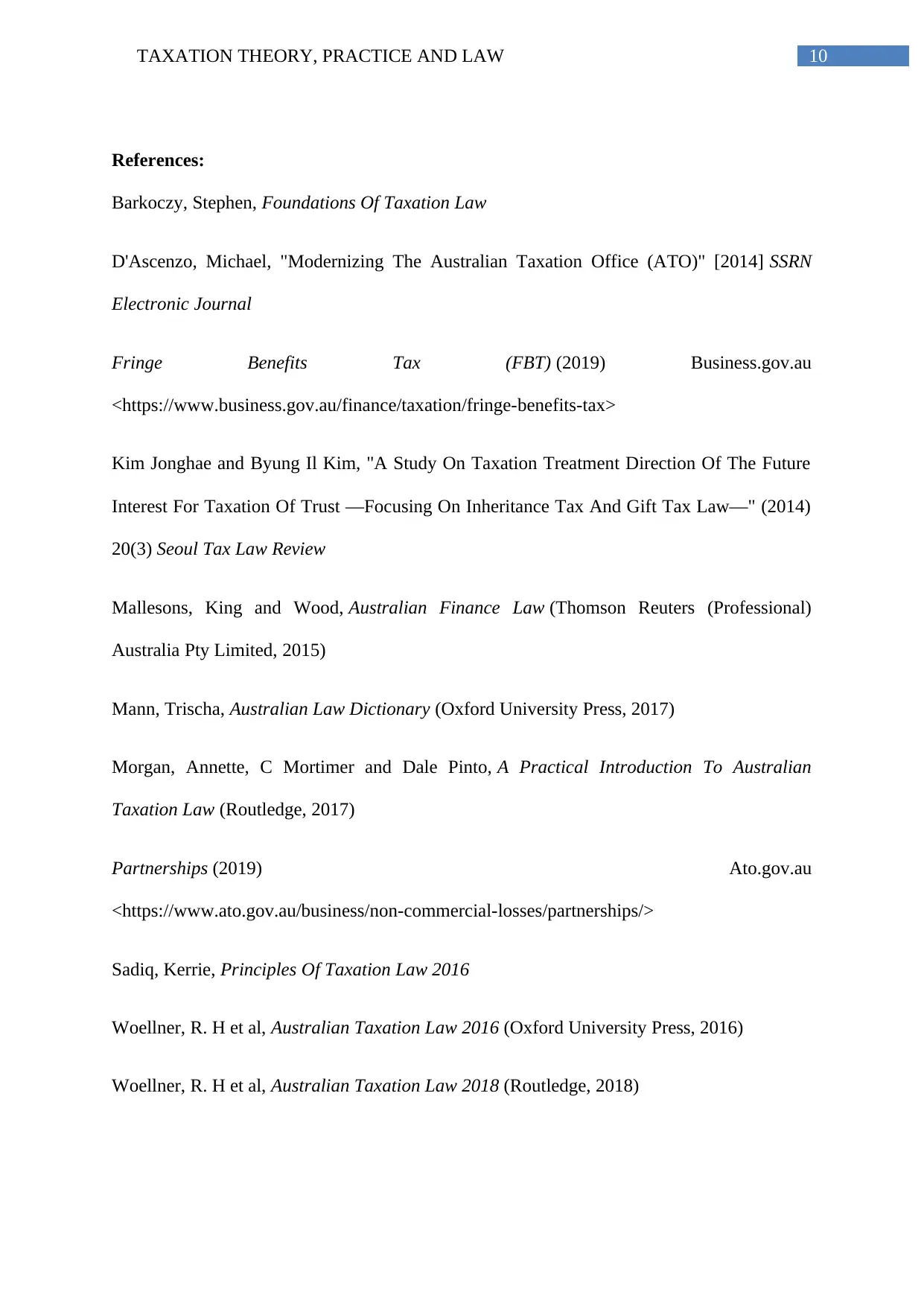
10TAXATION THEORY, PRACTICE AND LAW
References:
Barkoczy, Stephen, Foundations Of Taxation Law
D'Ascenzo, Michael, "Modernizing The Australian Taxation Office (ATO)" [2014] SSRN
Electronic Journal
Fringe Benefits Tax (FBT) (2019) Business.gov.au
<https://www.business.gov.au/finance/taxation/fringe-benefits-tax>
Kim Jonghae and Byung Il Kim, "A Study On Taxation Treatment Direction Of The Future
Interest For Taxation Of Trust ―Focusing On Inheritance Tax And Gift Tax Law―" (2014)
20(3) Seoul Tax Law Review
Mallesons, King and Wood, Australian Finance Law (Thomson Reuters (Professional)
Australia Pty Limited, 2015)
Mann, Trischa, Australian Law Dictionary (Oxford University Press, 2017)
Morgan, Annette, C Mortimer and Dale Pinto, A Practical Introduction To Australian
Taxation Law (Routledge, 2017)
Partnerships (2019) Ato.gov.au
<https://www.ato.gov.au/business/non-commercial-losses/partnerships/>
Sadiq, Kerrie, Principles Of Taxation Law 2016
Woellner, R. H et al, Australian Taxation Law 2016 (Oxford University Press, 2016)
Woellner, R. H et al, Australian Taxation Law 2018 (Routledge, 2018)
References:
Barkoczy, Stephen, Foundations Of Taxation Law
D'Ascenzo, Michael, "Modernizing The Australian Taxation Office (ATO)" [2014] SSRN
Electronic Journal
Fringe Benefits Tax (FBT) (2019) Business.gov.au
<https://www.business.gov.au/finance/taxation/fringe-benefits-tax>
Kim Jonghae and Byung Il Kim, "A Study On Taxation Treatment Direction Of The Future
Interest For Taxation Of Trust ―Focusing On Inheritance Tax And Gift Tax Law―" (2014)
20(3) Seoul Tax Law Review
Mallesons, King and Wood, Australian Finance Law (Thomson Reuters (Professional)
Australia Pty Limited, 2015)
Mann, Trischa, Australian Law Dictionary (Oxford University Press, 2017)
Morgan, Annette, C Mortimer and Dale Pinto, A Practical Introduction To Australian
Taxation Law (Routledge, 2017)
Partnerships (2019) Ato.gov.au
<https://www.ato.gov.au/business/non-commercial-losses/partnerships/>
Sadiq, Kerrie, Principles Of Taxation Law 2016
Woellner, R. H et al, Australian Taxation Law 2016 (Oxford University Press, 2016)
Woellner, R. H et al, Australian Taxation Law 2018 (Routledge, 2018)
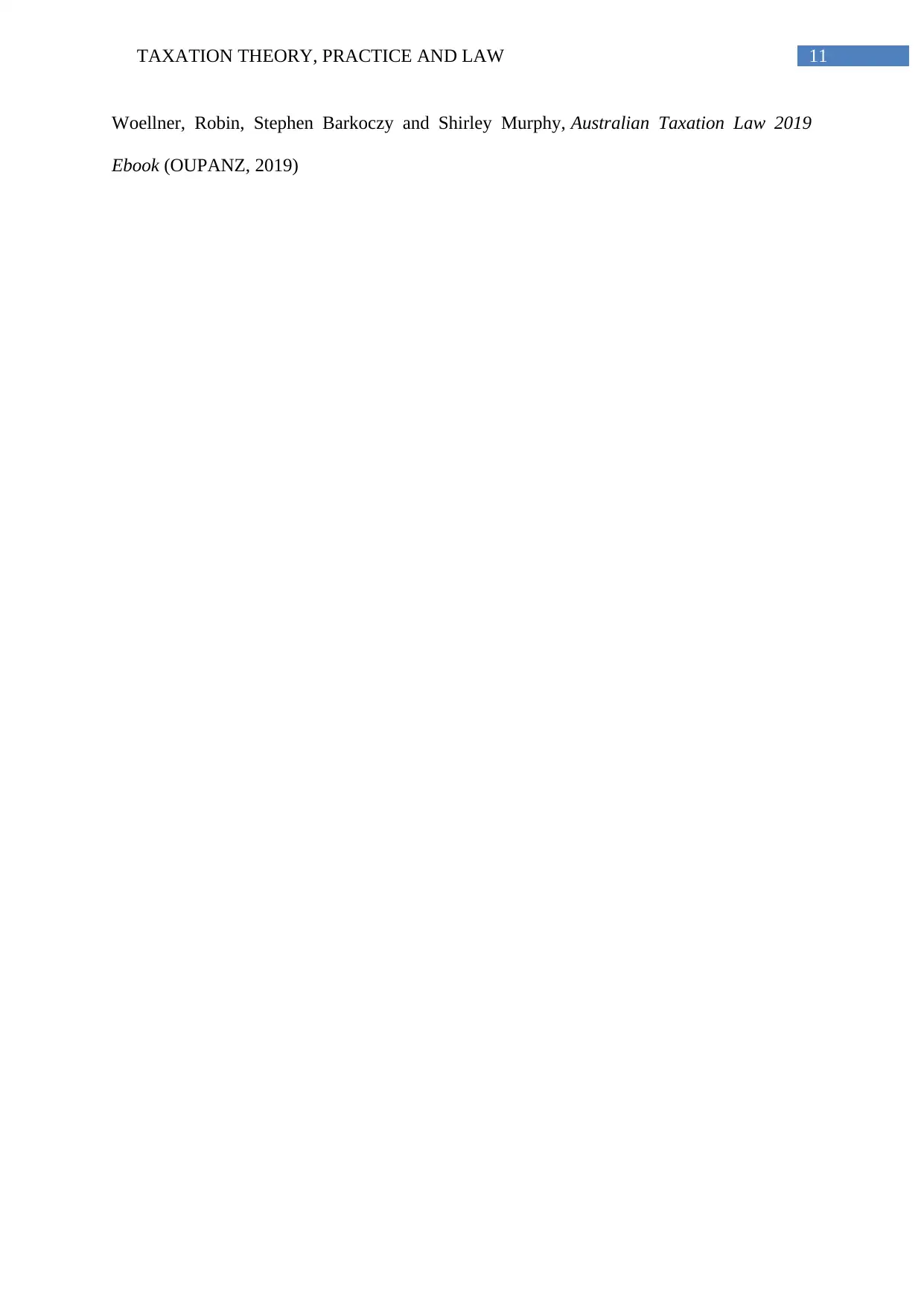
11TAXATION THEORY, PRACTICE AND LAW
Woellner, Robin, Stephen Barkoczy and Shirley Murphy, Australian Taxation Law 2019
Ebook (OUPANZ, 2019)
Woellner, Robin, Stephen Barkoczy and Shirley Murphy, Australian Taxation Law 2019
Ebook (OUPANZ, 2019)
⊘ This is a preview!⊘
Do you want full access?
Subscribe today to unlock all pages.

Trusted by 1+ million students worldwide
1 out of 12
Related Documents
Your All-in-One AI-Powered Toolkit for Academic Success.
+13062052269
info@desklib.com
Available 24*7 on WhatsApp / Email
![[object Object]](/_next/static/media/star-bottom.7253800d.svg)
Unlock your academic potential
Copyright © 2020–2025 A2Z Services. All Rights Reserved. Developed and managed by ZUCOL.




